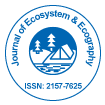Our Group organises 3000+ Global Conferenceseries Events every year across USA, Europe & Asia with support from 1000 more scientific Societies and Publishes 700+ Open Access Journals which contains over 50000 eminent personalities, reputed scientists as editorial board members.
Open Access Journals gaining more Readers and Citations
700 Journals and 15,000,000 Readers Each Journal is getting 25,000+ Readers
Google Scholar citation report
Citations : 2854
Journal of Ecosystem & Ecography received 2854 citations as per Google Scholar report
Journal of Ecosystem & Ecography peer review process verified at publons
Indexed In
- CAS Source Index (CASSI)
- Index Copernicus
- Google Scholar
- Sherpa Romeo
- Online Access to Research in the Environment (OARE)
- Open J Gate
- Genamics JournalSeek
- Ulrich's Periodicals Directory
- Access to Global Online Research in Agriculture (AGORA)
- Electronic Journals Library
- RefSeek
- Hamdard University
- EBSCO A-Z
- OCLC- WorldCat
- SWB online catalog
- Virtual Library of Biology (vifabio)
- Publons
- Geneva Foundation for Medical Education and Research
- Euro Pub
Useful Links
Recommended Journals
Share This Page
Analyzing omics data using compositional data analysis
Joint Conference International Conference on Environmental Microbiology and Microbial Ecology & International Conference on Ecology and Ecosystems
Gregory B Gloor
University of Western Ontario, Canada
ScientificTracks Abstracts: J Ecosyst Ecography
Abstract
We will demonstrate that the microbiome and transcriptome datasets should be analyzed by a combination of Bayesian estimation and compositional data approaches to examine the ratios between features giving robust insights into the structure of high throughput sequencing datasets. Traditional methods of analyzing microbiome or RNA-seq datasets can be misleading, and not use all the available information. This results in many analyses being dominated by either the most abundant, or the rarest features. Data collected using high throughput sequencing (HTS) methods are sequence reads mapped to genomic intervals, and are commonly analyzed as either 'normalized count data├ó┬?┬? or 'relative abundance data├ó┬?┬?. One reason for these normalizations is to attempt to compensate for the problem that the sequencing instrument imposes an upper bound on the number of sequence reads. Positive data with an arbitrary bound are 'compositional data' and are subject to the problem of spurious correlation. Thus ordination, clustering and network analysis become unreliable. A second problem is that the data are sparse: i.e., contain many 0 values. A third problem is that the largest measurement error is at the low count margins in these datasets. These issues are all addressed using our approach.Biography
Greg B Gloor is a professor of biochemistry with broad experience in molecular biology, genetics and genomics. Most recently, he has developed tools to investigate fundamentals of molecular evolution, microbial ecology and meta-transcriptomics. He is currently working on developing and adapting principled methods to characterize correlation and differential abundance in sparse, high throughput sequencing data as generated in 16S rRNA gene sequencing surveys, meta-genomics and metatranscriptomics. He is the developer and maintainer of the ALDEx2 R package on Bioconductor.

 Spanish
Spanish  Chinese
Chinese  Russian
Russian  German
German  French
French  Japanese
Japanese  Portuguese
Portuguese  Hindi
Hindi 
